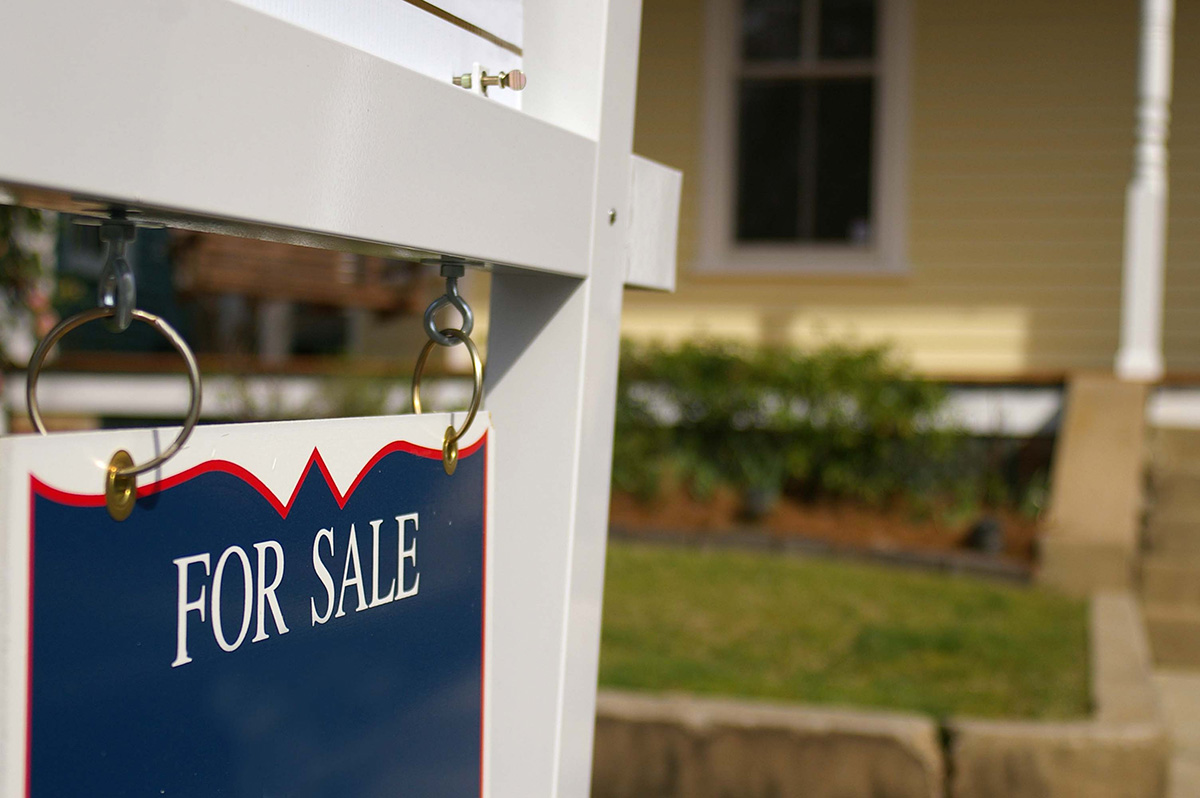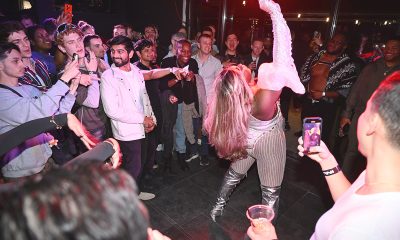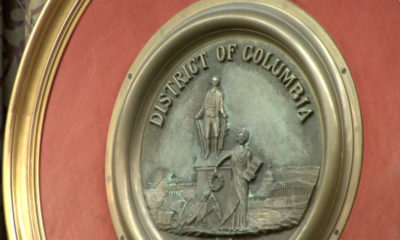Living
Queer conference explores language
Nuances exposed and examined — including porn star grunts, according to organizer

Organizers of the Lavender Language Conference say even the sounds gay porn actors make in the throes of passion have meaning and can teach us something about our gay lives. (Photo via Wikimedia)
Lavender Languages & Linguistics Conference
Friday through Sunday
American University
Washington
Prices vary — presentations may be attended individually and cost $25 per session for employed persons; discounts available for anyone who wants to attend but can’t afford to pay
Registration is possible on site or online
American.edu/lavenderlanguages
Watching gay porn at William Leap’s house near American University in Washington can be tedious.
“There’s a lot of hilarity with that,” Leap says. “My partner always wants to race through it. He says, ‘Oh, come on, this is stupid,’ and I’m like, ‘No, I need to listen to this. I want to hear the dialogue and really think about what phrases they’re saying.”
And yes, in a way, Leap does have a dialogue fetish but it’s not sexual. He’s a linguistics specialist and professor at American University in its College of Arts and Sciences’ Department of Anthropology. His 20th annual Lavender Languages & Linguistics Conference, which he says is the longest-running queer academic conference in North America, convenes today. He and a stable of other academics will welcome about 150 attendees from around the world to a weekend jammed with about 80 presentations on queer language. Language used in gay porn is just one of the many topics that will be covered.
“We have a guy coming, and this is such a hoot,” Leap says with palpable glee, “who’s doing a presentation comparing the sounds guys make in coital ecstasy with the sounds animals make in the zoo and in the wild. He’s actually doing a phonetic technical analysis and comparison to see how, for instance, [gay porn star] Damien Crosse grunts, so I don’t know, we’ll see what he comes up with.”
But even with nods to porn and gay pop culture, isn’t the conference a bit on the geeky and dry side? Leap says no and that the use of language — from the way words are spoken to the origins of phrases and expressions — has a profound effect on LGBT lives. Yes, it’s his pet passion, but he says there’s something any queer person could find useful in the event.
“I think the real value in it is that it reminds us that gay is not a single phenomenon and no one owns it,” Leap says. “No one has a right to stand up and speak for all queer people and part of what we have to do as academics is make it clear that there’s this vast diversity of things associated with the use of language. Gays and lesbians have a rich history that has largely been ignored. These cultural experiences are not being talked about in textbooks.”
Leap started the event in 1993 with a half-day event and about 85 in attendance. Now it’s three days and he expects about 150 to register in addition to “walk ins” who come for “a session or two.” It’s a non-profit event and Leap says those who are interested but can’t pay will not be turned away or denied lunch/refreshments. He also says there’s a refreshing non-snob factor with the professors whom he encourages to mingle with attendees from all walks of life.
“There’s no attitude here, no prima donnas,” he says. “We really want an environment where everybody is free to talk to everybody.”
David Peterson, a gay associate professor in the Department of English at the University of Nebraska at Omaha, has been attending and presenting almost every year since 1995. He says the topics that have been explored over the years at the Conference have endless “real world” implications for LGBT people.
“If we want to counter the kinds of things the Family Research Council, for example, is doing, we have to have some understanding of what they’re doing or it won’t be effective,” he says. “We can’t just protest it and say, ‘They’re just fundamentalist Bible thumpers,’ because they’re really not. It’s quite interesting, and not what many people would expect, that they don’t use a lot of scripture quoting on their website and in their arguments. … There’s been a shift. One of the things they do is pretend to be social scientists saying very homophobic things in what appears to be the objective language of science.”
Leap is happy to go anywhere during a phone chat this week. During an hour-plus conversation, he touched on dozens of topics. Among them:
• On understanding how gay language has changed in 20 years: “One of the most important things we’ve learned is that 20 years ago, many folks thought there was a gay language, a gay way of talking where you could identify a particular accent or a single way of doing things and while there’s probably some truth to that, what we’re realizing now is it’s terribly complex. There is no single way of talking, there is no such thing as a gay accent and it really varies across different groups, segments, classes and cultures. … You try to translate a phrase like “coming out of the closet” into French, for example, and their reaction would be, ‘Why would I be in a wardrobe?’ … If they’re actually talking about telling family and friends they’re gay, they would say it in an altogether different way and that’s just one example. Referring to the ‘gayborhood,’ is another that just has no French equivalent. And that’s just using French as an example. You can imagine how this varies around the world.”
• Is faggot the new “n word”? “Well, yes and no,” Leap says. “A lot of guys use it as a term of self reference but get very angry if somebody else says it about them, so for many it is. It’s kind of like the high school expression, ‘That’s so gay,’ which is widely used as a bullying term. I don’t think this needs a whole lot of theorizing. It’s like queer was 20 years ago. We kind of took it back, made a joke of it and said, ‘You don’t own this term.’ We can do that with fag if we want.”
• Norman Lear could have Archie Bunker say fag on a sitcom 30 years ago but now celebrities who use the word get criticized and not just by GLAAD. What does that say about how language usage has changed? “It’s good because it keeps our issues on the front burner,” Leap says. “Yes, things have come a long way, but I still worry until we have some serious workplace protections in place. All these things we can do to keep that visibility going are good.”
• You say there’s no such thing as gay language, but you hear people say things like, “He was hot until he opened his mouth and a pink umbrella fell out.” People seem to know, at least among gay men in the U.S., pretty universally what that means. Thoughts? “It could be tone, it could be pitch. It’s really interesting because what it really shows us is that there’s no single thing as gay language, it’s really everyone’s perception of it. What they believe gay language to be.”
• Some celebs, when they come out, are very unequivocal. Others, such as Jodie Foster at the Golden Globes last month, don’t use the word lesbian, yet everyone watching knew what she meant. Does that cut it? “Of course it matters. Anyone who’s in a position of relative safety and privilege, should. I’m not going to say she should have, but I would have thought it would have been great and would have meant more to the 9-year-old girl watching. And yet what she did was absolutely wonderful and I’m dying to see a transcript of it, because you’re right, while everybody knew what she meant and it was her most direct statement yet, it was also terribly opaque on some levels. It’s a great example of using language in an indirect way though yeah, it would have been great if she’d just used the L word and been done with it.”
• LGBT has some universality to it, but people, in a quest to be inclusive, have added letters for those questioning, allies and so on. Is that OK? “This is when you see why the word queer has some appeal because it can encompass a whole range of counter-normative identities, aspirations and desires. And yes, this LGBTQ-adding on of letters gets to be this ridiculous alphabet soup where you can’t possibly include everybody in the phone book. A lot of it, for men who are same-sex identified, is, ‘Do you suck cock?’ But even then you have people, like Larry Craig, who are straight identified but like to suck cock. I don’t know about you, but I don’t want him on my team. One of the interesting things this leads to is how people make sense of themselves. You really start to see how many nuances there are to queer language.”

Electric-vehicle tax credits may have faded earlier this year, but EVs themselves are far from losing their spark. There are more charging stations than ever, battery ranges are longer and more realistic, and automakers have finally figured out that EVs don’t all need to look like geeky science projects or feel like failed beta tests.
Just look at these two compact electrics, which are futuristic, fun and flexible enough for work or play.
HYUNDAI IONIQ 5
$37,000 to $48,000
Range: 245 to 318 miles
0 to 60 mph: 4.5 to 7.4 seconds
Cargo space: 26.3 cu. ft.
PROS: Fast charging. Roomy cabin. Silky-smooth suspension.
CONS: Wide turning radius. Rear wiper not on all trims. Price creep.
After being introduced three years ago, what’s new for the latest Hyundai Ioniq 5? Mostly refinement. Charging is quicker, software is smarter and Hyundai continues to quietly listen to feedback, tweaking ride comfort and usability. Think of it as switching from messy eyeliner to a perfectly sharp wing.
Exterior styling remains one of this EV’s biggest conversation starters. Those pixel-inspired lights, crisp lines and slick hatchback-meets-crossover proportions exude refreshing confidence. There’s no trying to blend in, and that’s the point. Park this Hyundai anywhere and heads will turn.
On the road, the Ioniq 5 prioritizes calm over chaos. Steering is light, the suspension smooths out rough pavement and acceleration feels brisk without being aggressive. Safety tech is plentiful and well-calibrated—adaptive cruise control, lane-centering, blind-spot monitoring—all working together without seeming like a nervous backseat driver. IOW, this ride is supportive, not clingy.
Inside, the user-friendly cabin shines. The flat floor and long wheelbase create a lounge-like atmosphere, with excellent legroom and airy visibility. Seats are well-bolstered and available with eco-friendly materials, and the sliding center console adds flexibility. Cargo space is generous, and the wide windshield makes city driving stress-free. Alas, the rear wiper is only available on select models. Overall, though, I appreciated how everything looks modern without feeling cold.
What makes this Hyundai special is its vibe. An EV that embraces individuality without shouting about it.
Fun fact: The Ioniq’s ultra-fast charging can add hundreds of miles in under 20 minutes—perfect for those who hate waiting almost as much as they hate small talk on awkward first dates.
VOLKSWAGEN ID.4
$46,000 to $59,130
Range: 206 to 291 miles
0 to 60 mph: 4.4 to 7.7 seconds
Cargo space: 30.3 cu. ft.
PROS: Sure handling. Decent range. Good storage.
CONS: Body roll in curves. Fussy infotainment. No frunk.
The latest VW ID.4 focuses on polish. Software updates have fixed earlier frustrations, and overall drivability feels more cohesive. Less “learning curve” and more “hop in and go,” like a dependable bestie who doesn’t overthink things.
Styling-wise, this EV is intentionally inoffensive. Soft curves, friendly lighting and a familiar crossover shape make it approachable. While the ID.4 won’t turn heads like the Ioniq 5, that’s OK. It’s more akin to a classic outfit that always works—timeless, not trendy.
Driving the ID.4 is relaxed and predictable. This SUV prioritizes comfort over thrills, with a suspension tuned for daily commuting and long highway drives. Safety features are comprehensive and reassuring, including excellent lane assistance and collision-prevention systems. It’s the kind of car that quietly has your back, no drama required.
Inside, the ID.4 offers a calm, uncluttered cabin with good space for passengers and cargo alike. Rear-seat legroom is especially strong, making it a solid road-trip companion. The seats are plush, visibility is good and while the infotainment system isn’t the most intuitive, it’s improved enough to be more than tolerable.
The ID.4’s special sauce is balance. It doesn’t try to reinvent the wheel—it just electrifies it.
Fun fact: This is one of the most globally popular EVs, proving that sometimes being universally liked is a strength, not a personality flaw. Think, gold star gay who still surprises you.

Real Estate
Child- and pet-proofing your home for the holidays
It isn’t about being perfect but about being prepared

The holidays are meant to be joyful, cozy, and full of laughter — but if you have young children or pets, they can also feel a little chaotic. Twinkling lights, shiny decorations, guests coming and going, and tables full of tempting food can turn your home into a wonderland of curiosity and mischief. The good news? With a little thoughtful planning, you can keep the holiday magic alive while making your home safer for everyone who lives there.
There’s something oddly comforting about movies where animals go to war with holiday decorations, turning carefully strung lights and perfectly placed ornaments into chaos. Whether it’s a mischievous dog tangled in tinsel or a curious cat launching a full-scale assault on a Christmas tree, these scenes tap into a universal experience for pet owners.
The humor comes from the contrast: the human characters are trying to create warmth, tradition, and picture-perfect cheer, while the animals see the decorations as toys, obstacles, or personal enemies. The resulting destruction — trees tipping over, ornaments shattering, lights blinking out—feels exaggerated but relatable, especially during the already hectic holiday season.
Let’s start with decorations because they tend to be the biggest attraction. Ornaments sparkle, garlands dangle, and everything seems designed to be touched, pulled, or tasted. If you have little ones or pets, consider placing your most fragile ornaments higher on the tree and using shatterproof options on the lower branches. Tinsel and ribbon may look festive, but they can be dangerous if swallowed, so skipping them or keeping them well out of reach is a simple way to reduce risk without sacrificing style.
Holiday lights are another favorite fascination. Before hanging them, take a few minutes to inspect each strand for frayed wires or broken bulbs. Secure cords along walls or behind furniture so they’re harder to grab or chew and unplug them when you leave the house or head to bed. Not only does this help prevent accidents, but it also gives you one less thing to worry about during a busy season.
The Christmas tree itself can become a focal point for exploration. Make sure it’s sturdy and well-anchored so it doesn’t tip if a toddler tugs on a branch or a pet decides to investigate. If you use a real tree, cover the water base since tree water can contain additives that aren’t safe if consumed. For artificial trees, keep an eye out for loose pieces or needles that could become choking hazards.
Food is a big part of holiday celebrations, and it’s also one of the most common sources of trouble. Many traditional treats—like chocolate, grapes, raisins, alcohol, and foods containing xylitol—are dangerous for pets. Keep plates and serving dishes up high, secure the trash can, and gently remind guests not to slip pets or kids “just a little bite” without checking first. For children, be mindful of hard candies, nuts, and small treats that could pose choking risks.
Candles and fireplaces add warmth and charm, but they deserve extra caution. Flameless candles are a wonderful alternative if you want ambiance without worry. If you do use real candles, place them well out of reach and never leave them unattended. Fireplaces should always have a sturdy screen or gate, especially with crawling babies or curious pets nearby.
Holiday gatherings bring wonderful energy into your home, but they can also create new challenges. Doors opening frequently make it easier for pets to slip outside, so consider setting up a quiet, comfortable space where they can relax during busy get-togethers. This can help reduce stress for them and give you peace of mind. For children, stair gates, locked cabinets, and clear boundaries can help prevent accidents when there’s extra excitement in the air.
New toys and gifts are another thing to watch closely. Packaging, twist ties, plastic wrap, and especially button batteries should be cleaned up promptly. These items are easy to overlook in the excitement of gift-opening but can be dangerous if swallowed. Taking a few minutes to tidy up as you go can make a big difference.
Lastly, try to keep routines as steady as possible. The holidays naturally disrupt schedules, but familiar mealtimes, naps, walks, and bedtime rituals help children and pets feel secure. A calmer household often means fewer accidents and a happier experience for everyone.
At the end of the day, child- and pet-proofing your home for the holidays isn’t about being perfect but about being prepared. A few small adjustments can help you relax, enjoy your guests, and focus on what truly matters: creating warm, happy memories with the ones you love. When your home feels safe, the holidays feel even sweeter.
Valerie M. Blake is a licensed Associate Broker in D.C., Maryland, and Virginia with RLAH @properties. Call or text her at 202-246-8602, email her at [email protected] or follow her on Facebook at TheRealst8ofAffairs.
Real Estate
In real estate, trust the process
With rates coming down, we could see spring surge in buyers

The average 30-year mortgage rate is falling, little by slowly. With predictions that the rate will continue to adjust downward in the next year or two, there may be a busier spring market than we have seen in the last few year, especially for the DMV market, which has been reeling from thousands of layoffs this past year. The frenzied activity resulting from interest rates close to 3% for some borrowers will probably not occur; however, this spring could add up to be a few notches busier than the last.
What does this mean for buyers and sellers? Lender Tina Del Casale with Waterstone Mortgage says she has seen “low to mid 6’s as the average for conventional loans.” If rates continue downward into the 5% range, there may be more activity than we saw in the last year or two. This could release a little bit of pent up demand.
Many buyers will have found that for whatever reason, their current home is not meeting their needs. Sellers may want to finally take the plunge and put a for sale sign in the yard and online, now that they might find a more reasonable rate on their next home. This winter can be an opportunity to assess financial situations, home conditions, and optimize one’s chances to have a sale with more agreeable terms, or put one’s best foot forward in an offer. In addition to checking with a lender or favorite handy person, let’s review what sellers and buyers typically spend their energy negotiating while enjoying the lovely process called “going under contract”:
- Timelines – Sellers might want to have their house solidly under contract (papers signed, thumbs up from the lenders, all inspection items decided upon and settled) so that they can put an offer down on a new home, and then negotiate that timeline with the other sellers. Remember, making a move is not only about the buyer taking possession of a new home, but also about the sellers figuring out their situation as well.
- Sale Price – unfortunately for buyers, in the eyes of most sellers, “money talks.” So, in a non-competitive situation, a seller might be happy to just get one offer at a price that was within the desired range. As soon as another interested buyer enters the equation, it can become a little bit like RuPaul’s Drag Race, and one will have to lip sync for one’s life, honey! And only one buyer will get to hear the words, “condragulations!”
- Tone/Vibes/Energy in the Room – Remember: Human beings are emotional creatures. All of us have feelings. And all of us want to put energy into situations where we feel appreciated, where a level of self-awareness exists, and a sense that each side is trying one’s hardest to act in good faith. The best transactions I saw were where a little grace was the “grease on the wheels” of the transaction. Occasionally, a buyer had cold feet and wanted to see the unit a few more times before the settlement date, or a seller forgot to scrub the bathroom with a little extra elbow grease before the settlement date. Life happens; misunderstandings can occur. A wise therapist once said: “You don’t have to like it, but can you allow it?” The tone of one or both parties in the transaction can be what seals the deal, or results in one party exiting the contract. (In the case of the dirty bathroom, the seller left a check with the title company for the buyer to pay a housekeeper to come clean what they couldn’t.)
Joseph Hudson is a referral agent with Metro Referrals. He can be reached at 703-587-0597 or [email protected].
-

 District of Columbia5 days ago
District of Columbia5 days agoBrian Footer suspends campaign for Ward 1 D.C. Council seat
-

 Opinions5 days ago
Opinions5 days ago2026 elections will bring major changes to D.C. government
-

 Kazakhstan4 days ago
Kazakhstan4 days agoKazakh Senate approves anti-LGBTQ propaganda bill
-

 District of Columbia4 days ago
District of Columbia4 days agoNew queer bar Rush beset by troubles; liquor license suspended



















